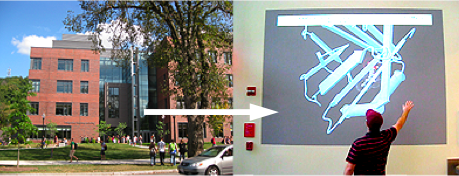Molecular Playground/ Copper-Zinc Superoxide Dismutase
From Proteopedia
| Molecular Playground at the University of Massachusetts. MOVIE. |
Proposed Article Title: Molecular Playground/Copper-Zinc Superoxide Dismutase
Banner: Cu/ Zn Superoxide Dismutase keeps you young
The important function of Cu/ Zn superoxide dismutase (SOD) is to detoxify damaging forms of oxygen. It catalyzes the dismutation of superoxide (O2-) anion into molecular oxygen (O2) and hydrogen peroxide (H2O2)[1]. Mutations or disruptions in the protein can exacerbate a number of diseases, such as amyotrophic lateral sclerosis (ALS) and diabetes[2]. One of the reported mutations involves the reduction of the disulfide bond, leading to a destabilized protein structure [2]. This mutation is featured in the fatal ALS disease. The motor neurons of individuals are affected, and voluntary muscle control is lost.
|
Human Cu/ Zn superoxide dismutases (SOD) are homodimer proteins, consisting of two identical monomers, found in the cytoplasm of cells. Each monomer contains one atom of Copper (Cu), and one atom of Zinc (Zn). Each Cu is bound to four nitrogen atoms in histidines and each Zn is bound to four atoms as well. A disulfide bond is also located in each monomer. Another interesting feature that contributes to the stability of the protein is the tight hydrophobic surface between the monomers and “the two halves of the βeta (β)- barrel core” [3]. Hydrophobic, Polar
3D structures of superoxide dismutase
References
- ↑ Superoxide dismutase in Wikipedia
- ↑ 2.0 2.1 Culotta VC, Yang M, O'Halloran TV. Activation of superoxide dismutases: putting the metal to the pedal. Biochim Biophys Acta. 2006 Jul;1763(7):747-58. Epub 2006 May 17. PMID:16828895 doi:10.1016/j.bbamcr.2006.05.003
- ↑ Battistoni A, Folcarelli S, Cervoni L, Polizio F, Desideri A, Giartosio A, Rotilio G. Role of the dimeric structure in Cu,Zn superoxide dismutase. pH-dependent, reversible denaturation of the monomeric enzyme from Escherichia coli. J Biol Chem. 1998 Mar 6;273(10):5655-61. PMID:9488695



